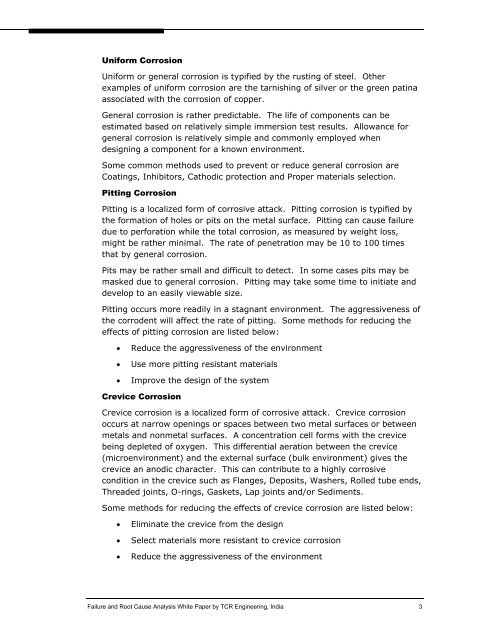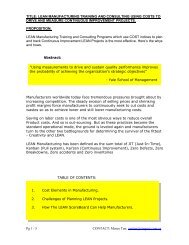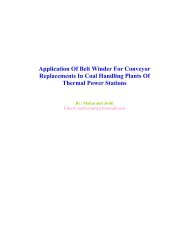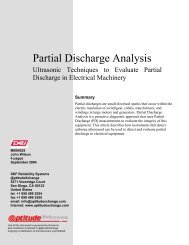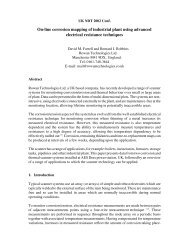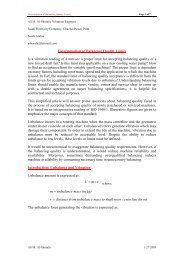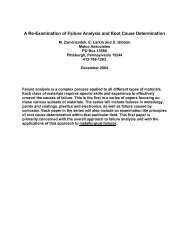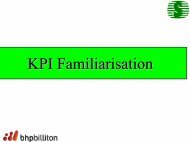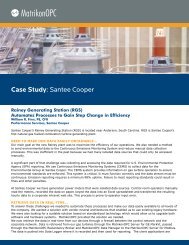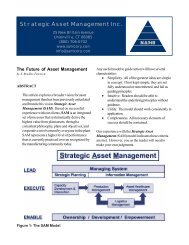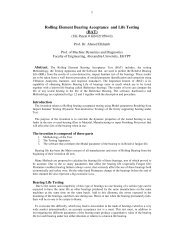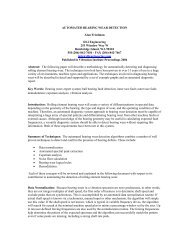Investigating Material and Component Failure - TCR Engineering ...
Investigating Material and Component Failure - TCR Engineering ...
Investigating Material and Component Failure - TCR Engineering ...
You also want an ePaper? Increase the reach of your titles
YUMPU automatically turns print PDFs into web optimized ePapers that Google loves.
Uniform Corrosion<br />
Uniform or general corrosion is typified by the rusting of steel. Other<br />
examples of uniform corrosion are the tarnishing of silver or the green patina<br />
associated with the corrosion of copper.<br />
General corrosion is rather predictable. The life of components can be<br />
estimated based on relatively simple immersion test results. Allowance for<br />
general corrosion is relatively simple <strong>and</strong> commonly employed when<br />
designing a component for a known environment.<br />
Some common methods used to prevent or reduce general corrosion are<br />
Coatings, Inhibitors, Cathodic protection <strong>and</strong> Proper materials selection.<br />
Pitting Corrosion<br />
Pitting is a localized form of corrosive attack. Pitting corrosion is typified by<br />
the formation of holes or pits on the metal surface. Pitting can cause failure<br />
due to perforation while the total corrosion, as measured by weight loss,<br />
might be rather minimal. The rate of penetration may be 10 to 100 times<br />
that by general corrosion.<br />
Pits may be rather small <strong>and</strong> difficult to detect. In some cases pits may be<br />
masked due to general corrosion. Pitting may take some time to initiate <strong>and</strong><br />
develop to an easily viewable size.<br />
Pitting occurs more readily in a stagnant environment. The aggressiveness of<br />
the corrodent will affect the rate of pitting. Some methods for reducing the<br />
effects of pitting corrosion are listed below:<br />
• Reduce the aggressiveness of the environment<br />
• Use more pitting resistant materials<br />
• Improve the design of the system<br />
Crevice Corrosion<br />
Crevice corrosion is a localized form of corrosive attack. Crevice corrosion<br />
occurs at narrow openings or spaces between two metal surfaces or between<br />
metals <strong>and</strong> nonmetal surfaces. A concentration cell forms with the crevice<br />
being depleted of oxygen. This differential aeration between the crevice<br />
(microenvironment) <strong>and</strong> the external surface (bulk environment) gives the<br />
crevice an anodic character. This can contribute to a highly corrosive<br />
condition in the crevice such as Flanges, Deposits, Washers, Rolled tube ends,<br />
Threaded joints, O-rings, Gaskets, Lap joints <strong>and</strong>/or Sediments.<br />
Some methods for reducing the effects of crevice corrosion are listed below:<br />
• Eliminate the crevice from the design<br />
• Select materials more resistant to crevice corrosion<br />
• Reduce the aggressiveness of the environment<br />
<strong>Failure</strong> <strong>and</strong> Root Cause Analysis White Paper by <strong>TCR</strong> <strong>Engineering</strong>, India 3


